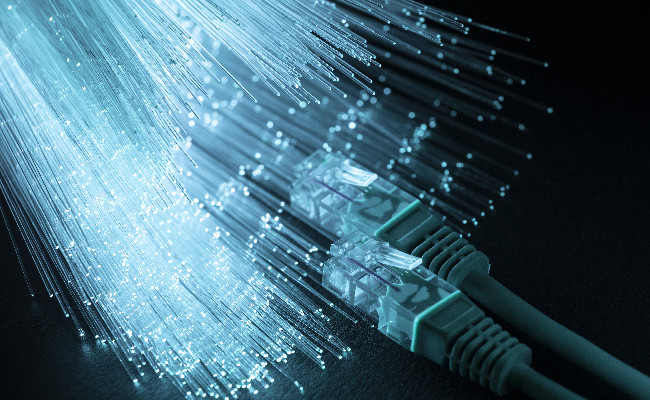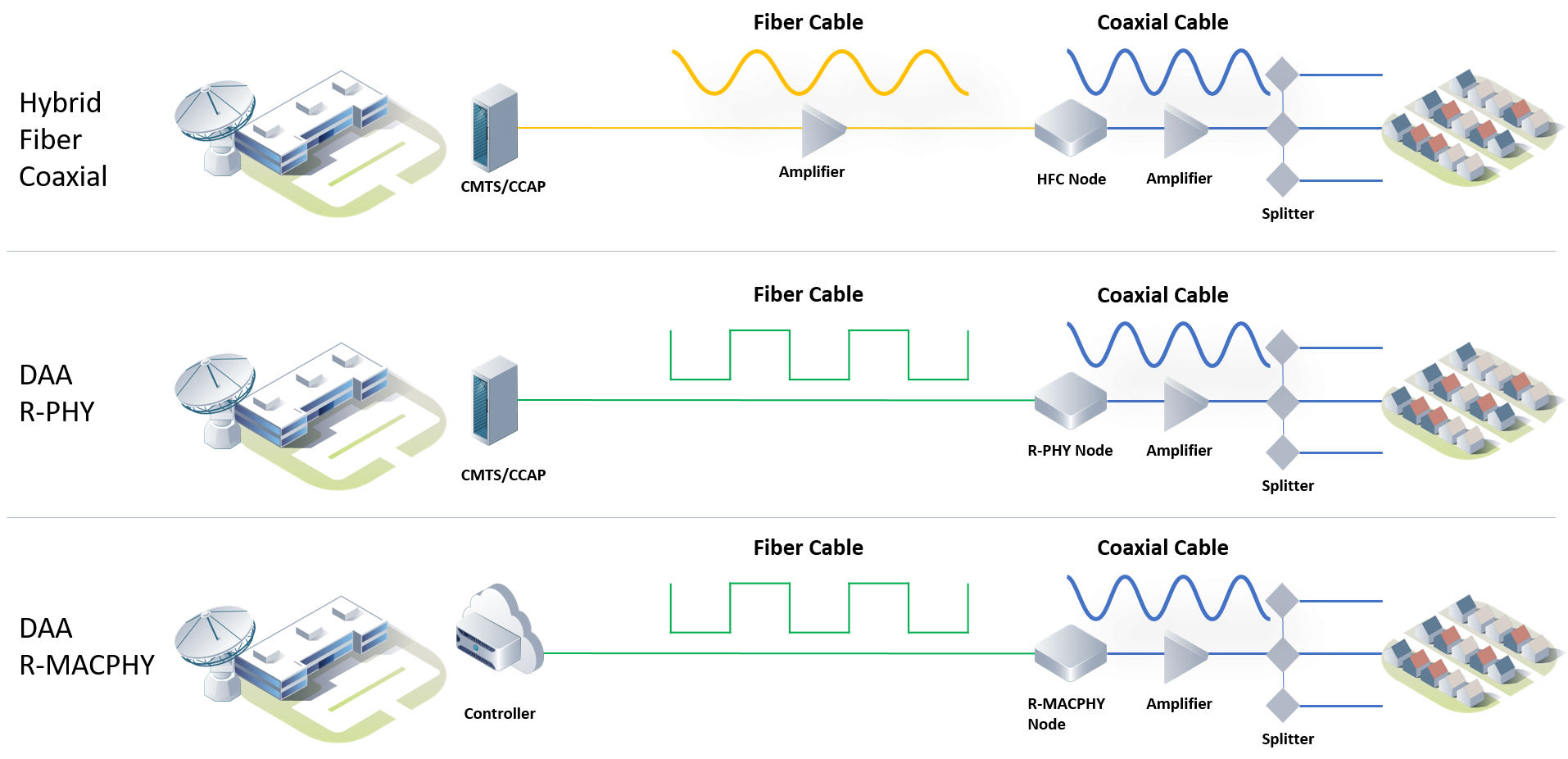Introducing Ethernet into Cable Networks: The Rise of DAA
by Winston Lai

Cable networks have grown over the past few decades to deliver different services to its subscribers. The emergence of applications such as IPTV, video on demand and 4K services has pushed the architecture of cable networks to evolve and become more stable and efficient. Cable operators are looking incorporating Ethernet technologies into their network as a means to address the growing bandwidth requirements brought forth by the new digital age.
A Distributed Access Architecture (DAA) is the latest development in cable network architectures for cable companies to enable next gen. services with minimal changes to their current network.
In this article we will dive into the foundations of cable network infrastructure, how they are evolving to DAA and what the benefits are for adopting DAA.
The Traditional Cable Network Infrastructure
When the cable network first come in during the mid-20th century, it was called Community Antenna Television (CATV) and was aimed at providing television programming to subscribers.

Traditional Cable Network Architecture
A cable network infrastructure was composed of a shared coaxial cable that transmits broadcast analog signal over 100 kilometers from the headend to each household, with data rates up to 50Mbits/sec. However, transmitting over long distances was problematic due to the attenuation of the signals, which required many amplifiers to maintain the signal’s integrity. Splitters are used to split the transmission signal to various neighborhoods and taps with drop cables are used to connect with the set-top box within the subscriber’s home.
What is a Coaxial Cable?
The coaxial cable is a cable that consists of an inner copper core cable that is surrounded with a layer of insulation and then additional outer layers of conductors. Coaxial cables been a staple of cable networks for decades and only in the last twenty years or so have been contended by fiber optic cables.
The development of fiber optic technology has put it above coaxial cables in terms of maintenance, life span, bandwidth and flexibility for introducing new services. As demand for more channels and programs grew, so did the demand for bandwidth. This led the way to the development of hybrid fiber coaxial (HFC) cable systems where fiber optics started to take a larger role within the cable network infrastructure.
Introduction of Hybrid Fiber Coaxial (HFC)
In the early 1990s, Hybrid Fiber Coaxial (HFC) became available following the discovery of fiber optics a decade earlier. Unlike legacy CATV systems, which uses only coaxial cables after headend, HFC uses optical fiber and leaves the last mile to be connected with coaxial cable.
Using fiber instead of coaxial improves the bandwidth significantly up to multiple gigabits per second. It is also less susceptible to signal degradation compared to coaxial systems. Furthermore, less maintenance is needed for because fiber optics are less susceptible performance deteriorating due to aging.

Legacy CATV vs Hybrid Coaxial Cable Architecture
Data-over-Cable
With the rise of internet, cable service operators started thinking to leverage existing cable infrastructure to provide data service, which resulted in the organization of CableLabs.
CableLabs defined the Data-over-Cable Interface Specification (DOCSIS), which enables data transfer on within the cable network that was originally used for distributing CableTV signals. They introduced a CMTS (Cable Modem Termination System) that is located at the headend and used to modulate data and manage data transport.
Over time, the CMTS has evolved into the CCAP (Converged Cable Access Platform), which unifies the CMTS, switching, routing and QAM functions so that all data and video (TV) services can be handled together with single platform. At the consumer site, a cable modem is used to communicate with the CMTS/CCAP and provide network access for the subscribers.
Even though HFC has improved cable networks a lot compared to traditional cable systems, it was simply not enough to satisfy the latest DOCSIS 3.1 standards. High noise generated by analog links and cascading amplifiers still jeopardized signal quality, meaning it may not be able to provide higher bandwidth and this limited flexibility for network deployments. Therefore, cable operators were still looking for ways to improve the efficiency of their cable networks and lower the signal to noise ratio limitations imposed by analog optics. The answer to that was implanting a distributed access architecture (DAA).
What is a Distributed Access Architecture (DAA)?
Many discussions have been around about how DAA can help to address a more efficient cable network. The DAA includes two variations: PHY and MACPHY at the remote location.
Remote PHY
The remote-PHY architecture moves PHY functionality to a remote node closer to subscribers and the RF line cards are replaced with digital line cards in the CMTS/CCAP. As a result, the RF signals begins in the remote node instead of the headend, which reduces capital expenses, extends its range and lowers the noise. Doing so provides a higher signal to noise ratio and supports high order digital modulations required by DOCSIS 3.1 in the access network compared to legacy copper connections.
Remote MACPHY
Remote-MACPHY further moves the MAC layer from CMTS/CCAP into a remote node. It is literally creating a mini-CMTS/CCAP at the edge. By doing so, the remote node can gain more control over the network and eliminate the processing latency to the headend.

Comparison of HFC with two different types of DAA (R-PHY, R-MACPHY)
Benefits of DAA
With the migration to distributed access architecture, cable operators can reap the benefits of Ethernet within their cable networks. In the transport network, it can utilize the efficient and cost effective ethernet infrastructure to deliver the data and in the headend a scalable spine-and-leaf interconnect could be used to aggregate traffic between CMTS/CCAP and remote nodes.
Time synchronization requirements introduced by the separation of MAC and PHY can be also fulfilled by using PTP and SyncE provided by ethernet.

DAA with Spine and Leaf Interconnect and Timing Synchronization
Ethernet offers lower latency for real-time applications such as gaming and video conferencing, resulting in a more responsive network. It also offers greater scalability which makes it easier to expand the network as demand grows and greater flexibility, which can be integrated with other cloud-based applications.
DAA Leads to Open Disaggregation
In addition, as ethernet is extended in the DAA, adopting an open disaggregated transport network will remove vendor-lock in and enhance multi-vendor interoperability which lowers the CAPEX and OPEX for cable operators and encourages innovation in the cable industry. Therefore, in order to build a more flexible cable networks, it is imperative to migrate into Ethernet as it has taken a larger role to create benefits and potential in DAA networks.
UfiSpace’s S9500 and S9600 Series are aggregation routers that adopt the open disaggregated methodologies and ethernet-based PTP protocol. From 1G to 400G, they provide cable operators a powerful platform with high capacities to support a large quantity of subscriptions needed and aggregate large traffic in DAA architecture, with S9500 placing between headend and fiber optic node and S9600 placing before headend to the core. Additionally, these routers all include multiple timing interfaces (GNSS, ToD, 1PPS, and 10MHz) and support IEEE 1588v2 as well as SyncE with Class C timing accuracy to guarantee precise timing of aggregating traffic inside cable network.
For more information about how UfiSpace can support DAA and HFC networks, please contact our sales team.
